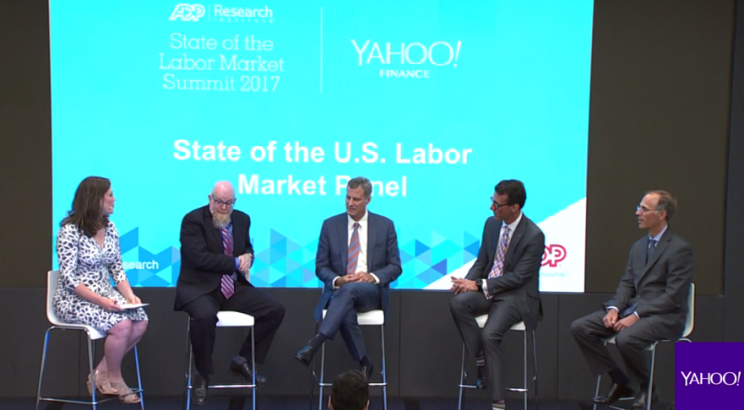Top economists debate the state of the U.S. labor market
Markets correspondent Nicole Sinclair sat down with top economists at the Nasdaq as part of ADP Research Institute’s State of the Labor Market Summit.
The discussion, which touched on the US labor market through the lens of empirical data, focused on trends taking shape today and their overall impact on the economy.
The panel included ADP’s CFO Jan Siegmund, Moody’s Analytics Chief Economist Mark Zandi, Professor of Economics at University of Chicago’s Booth School of Business Erik Hurst, and Professor of Economics and Public Affairs at Princeton University Alan Krueger. Krueger most recently served as Chairman of President Obama’s Council of Economic Advisers and a member of his Cabinet from 2011 to 2013.

“It’s almost machine like how impressive the job growth has been,” Zandi said. Since job growth resumed at the start of this decade, the US economy has created over 16 million jobs, or 2 to 2.5 million jobs each year. And with the current pace of job growth—close to 200,000 per month—the unemployment rate continues to improve, currently at 4.4%.
But the still-low participation rate (LFPR) along with still-feeble wage growth continue to present challenges, according to the economists.
In particular, the economists debated the contributing factors to the LFPR, or the percentage of working-age people who are either working or actively looking for work. The LFPR, which currently stands at just under 63% versus 67% 20 years ago, has largely been affected by an aging population, according to Zandi. But Krueger discussed other forces impacting the prime-age working population, including the opioid crisis and higher conviction records. And Hurst even added the impact of younger males playing more video games.
Meanwhile, Zandi said he’s optimistic about wage growth starting to pick up while Krueger emphasized the positive potential impact of raising the minimum wage.
As for the future, Zandi called for the coming “golden age of the American worker” while Hurst said he’s more worried about the threat of machines.
For the future, the whole panel remains concerned about potential policy choices to close off opportunities for trade and immigration, which could be detrimental for the labor market and economic growth.
Nicole Sinclair is markets correspondent for Yahoo Finance
Link to the full podcast on itunes:
https://itunes.apple.com/us/podcast/yahoo-finance-presents/id1241417570?mt=2
Please also see:
Short-sellers have lost $7.1 billion betting against this year’s hottest tech stocks
America doesn’t need to be the world leader to prosper
Bank of America CEO: Why it matters that 21% of our deposits are made through mobile
Low oil prices are hurting Pepsi’s business

